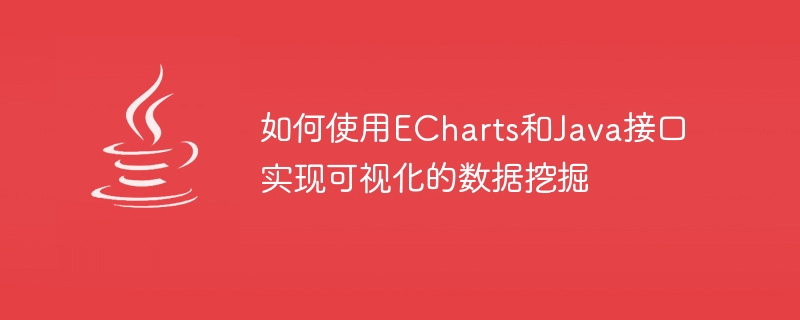

How to use ECharts and Java interfaces to implement visual data mining
[Introduction]
With the advent of the big data era, data mining has become an important technology plays an important role in corporate decision-making, market analysis and other fields. Data mining requires the analysis and display of large amounts of data, and visualization is an intuitive and vivid display method. This article will introduce how to use ECharts and Java interfaces to realize data mining visualization.
[Introduction to ECharts]
ECharts is a JavaScript-based visualization library open sourced by Baidu. It provides a wealth of chart types and interactive functions, and can be used to display various charts, maps, etc. on Web pages. Visualization. ECharts is powerful, easy to use, and suitable for visualization needs in various scenarios.
[Java Interface]
Java is a commonly used programming language with powerful data processing capabilities and rich development tools. Through Java, we can use various algorithms and libraries to process and analyze data, and then pass the processing results to ECharts for visual display.
[Implementation steps]
[Sample Code]
The following is a simple example that demonstrates how to use ECharts and the Java interface to implement pie chart data visualization:
Java code example:
import java.util.HashMap;
import java.util.Map;
public class Main {
public static void main(String[] args) {
// 数据处理
Map<String, Double> data = new HashMap<>();
data.put("苹果", 55.0);
data.put("橘子", 30.0);
data.put("香蕉", 15.0);
// 传递给ECharts
sendDataToECharts(data);
}
public static void sendDataToECharts(Map<String, Double> data) {
// 构造JSON数据,格式需符合ECharts要求
StringBuilder json = new StringBuilder();
json.append("[");
for (String key : data.keySet()) {
json.append("{");
json.append("'name':'").append(key).append("',");
json.append("'value':").append(data.get(key)).append("");
json.append("},");
}
json.deleteCharAt(json.length() - 1);
json.append("]");
// 通过网络传递给前端
String url = "http://localhost:8080/sendData";
HttpClient httpclient = new DefaultHttpClient();
HttpPost httppost = new HttpPost(url);
List<NameValuePair> params = new ArrayList<NameValuePair>();
params.add(new BasicNameValuePair("data", json.toString()));
httppost.setEntity(new UrlEncodedFormEntity(params, "UTF-8"));
HttpResponse response = httpclient.execute(httppost);
HttpEntity entity = response.getEntity();
}
}Front-end code example:
var data = [];
$.ajax({
type: 'POST',
url: '/sendData',
dataType: 'json',
success: function(response) {
data = response;
// 饼图配置
var option = {
series: [{
name: '水果销量',
type: 'pie',
radius: '55%',
data: data
}]
};
// 初始化ECharts,并渲染图表
var myChart = echarts.init(document.getElementById('chartContainer'));
myChart.setOption(option);
}
});Through the above example code, we have implemented data transfer and visual display between Java and ECharts. The data processing and ECharts configuration in the code can be adjusted according to specific needs and data characteristics to achieve richer and more complex data mining visualization.
[Conclusion]
This article introduces how to use ECharts and Java interfaces to implement visual data mining. The data is processed through Java and passed to the front end, and then visually displayed on the web page using ECharts. This method is flexible and can adapt to various data mining needs. I hope this article will be helpful to readers in applying ECharts and Java interfaces to realize data mining visualization in actual projects.
The above is the detailed content of How to use ECharts and Java interfaces to implement visual data mining. For more information, please follow other related articles on the PHP Chinese website!
